The first Scanning Electron Microscope was initially made by Mafred von Ardenne in 1937 with an aim to surpass the transmission electron Microscope. He used high-resolution power to scan a small raster using a beam of electrons that were focused on the raster. He also aimed at reducing the problems of chromatic aberrations images produced by the Transmission electron Microscopes. More studies followed by scientists and research institutions such as Cambridge Scientific Instrument Company who eventually developed a fully constructed Scanning electron Microscope, in 1965 and named it a Stereoscan. The price of the Scanning Electron Microscope (SEM) is approximately $1 million.
Interesting Science Videos
Scanning Electron Microscope (SEM) Definition
Scanning Electron Microscope (SEM) is a type of electron microscope that scans surfaces of microorganisms that uses a beam of electrons moving at low energy to focus and scan specimens. The development of electron microscopes was due to the inefficiency of the wavelength of light microscopes. electron microscopes have very short wavelengths in comparison to the light microscope which enables better resolution power.
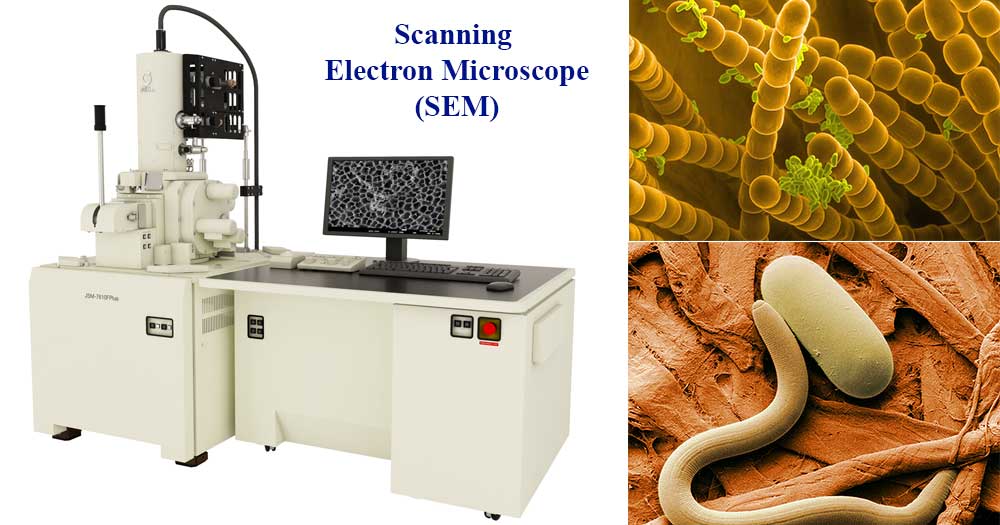
Principle of Scanning Electron Microscope (SEM)
Unlike the Transmission Electron Microscope which uses transmitted electrons, the scanning electron Microscope uses emitted electrons. The Scanning electron microscope works on the principle of applying kinetic energy to produce signals on the interaction of the electrons. These electrons are secondary electrons, backscattered electrons, and diffracted backscattered electrons which are used to view crystallized elements and photons. Secondary and backscattered electrons are used to produce an image. The secondary electrons are emitted from the specimen play the primary role of detecting the morphology and topography of the specimen while the backscattered electrons show contrast in the composition of the elements of the specimen.
How does the Scanning Electron Microscope (SEM) work?
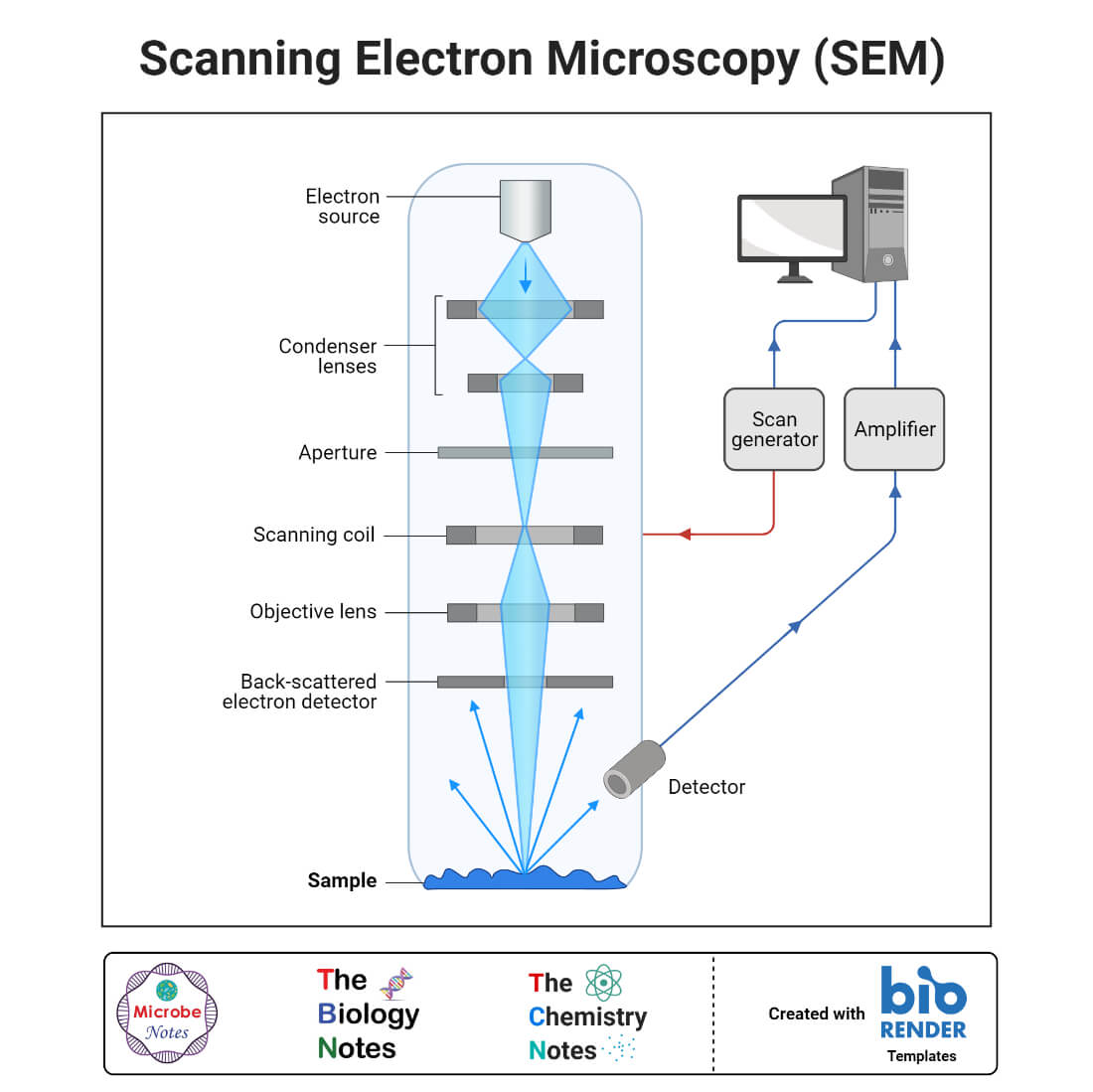
- The source of the electrons and the electromagnetic lenses are from tungsten filament lamps that are placed at the top of the column and it is similar to those of the transmission electron Microscope.
- The electrons are emitted after thermal energy is applied to the electron source and allowed to move in a fast motion to the anode, which has a positive charge.
- The beam of electrons activates the emission of primary scattered (Primary) electrons at high energy levels and secondary electrons at low-energy levels from the specimen surface. The beam of electrons interacts with the specimen to produce signals that give information about the surface topography and composition of the specimen.
- The specimen does not need special treatment for visualization under the SEM, even air-dried samples can be examined directly. However, microbial specimens need fixation, dehydration, and drying in order to maintain the structural features of the cells and to prevent collapsing of the cells when exposed to the high vacuum of the microscope.
- The samples are mounted and coated with thin layer of heavy metal elements to allow spatial scattering of electric charges on the surface of the specimen allowing better image production, with high clarity.
- Scanning by this microscope is attained by tapering a beam of electrons back and forth over a thin section of the microscope. When the electrons reach the specimen, the surface releases a tiny staw of electrons known as secondary electrons which are then trapped by a special detector apparatus.
- When the secondary electrons reach and enter the detector, they strike a scintillator (a luminescence material that fluoresces when struck by a charged particle or high-energy photon). This emits flashes of light which get converted into an electric current by a photomultiplier, sending a signal to the cathode ray tube. This produces an image that looks like a television picture that can be viewed and photographed.
- The quantity of secondary electrons that enter the detector is highly defined by the nature of the specimen i.e raised surfaces to receive high quantities of electrons, entering the detector while depressed surfaces have fewer electrons reaching the surface and hence fewer electrons enter the detector.
- Therefore raised surfaces will appear brighter on the screen while depressed surfaces appear darker.
Parts of a Scanning Electron Microscope (SEM)
The major components of the Scanning Electron Microscope include;
- Electron Source – This is where electrons are produced under thermal heat at a voltage of 1-40kV. the electrons condense into a beam that is used for the creation of an image and analysis. There are three types of electron sources that can be used i. e Tungsten filament, Lanthanum hexaboride, and Field emission gun (FEG)
- Lenses – it has several condenser lenses that focus the beam of electrons from the source through the column forming a narrow beam of electrons that form a spot called a spot size.
- Scanning Coil – they are used to deflect the beam over the specimen surface.
- Detector – It’s made up of several detectors that are able to differentiate the secondary electrons, backscattered electrons, and diffracted backscattered electrons. The functioning of the detectors highly depends on the voltage speed, the density of the specimen.
- The display device (data output devices)
- Power supply
- Vacuum system
Like the transmission electron Microscope, the Scanning electron microscope should be free from vibrations and any electromagnetic elements.
Scanning Electron Microscope (SEM) Images
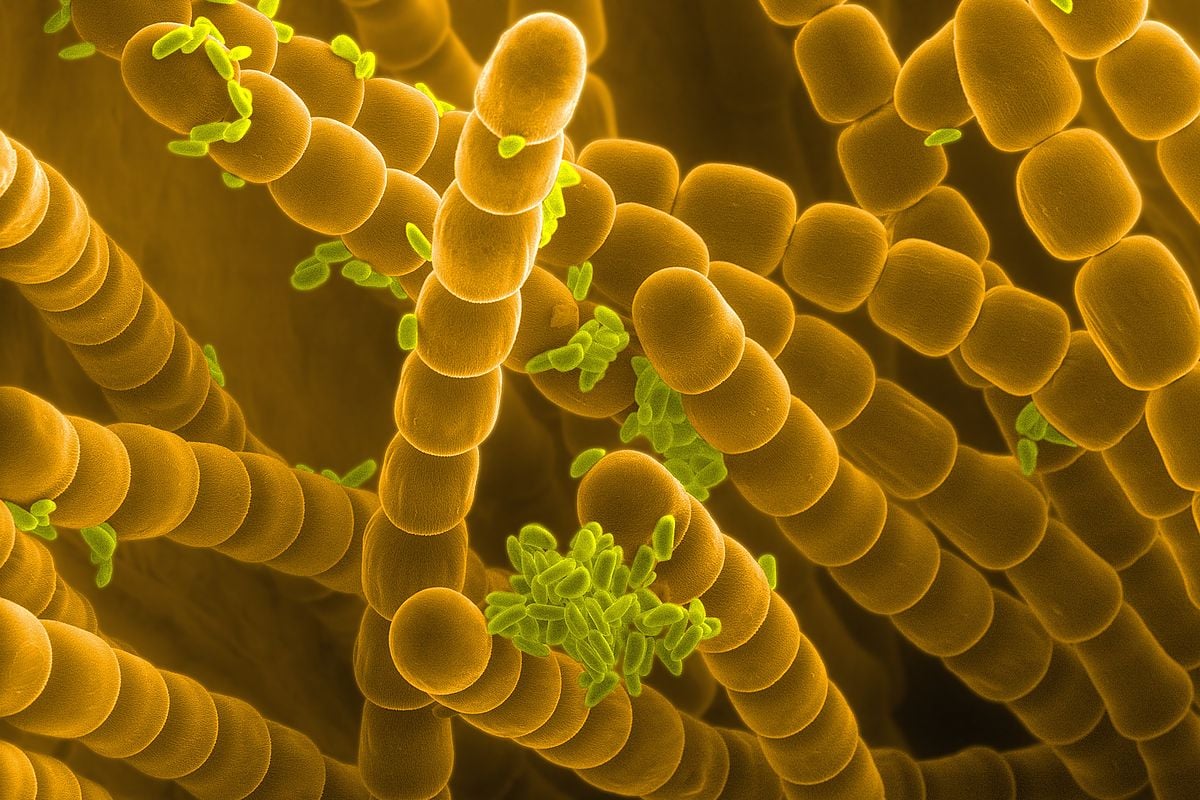
Figure: SEM image of Tradescantia pollen and stamens. Source: Wikipedia

Figure: Low-temperature scanning electron micrograph of soybean cyst nematode and its egg. Magnified 1,000 times. Source: Wikipedia
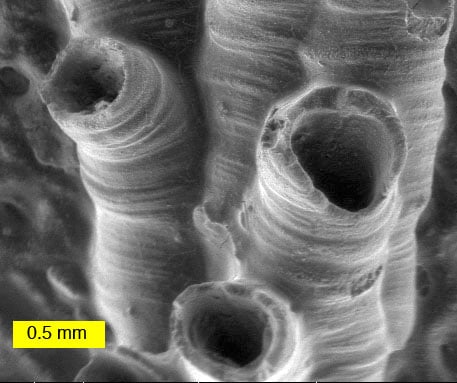
Figure: Scanning electron microscope image of a hederelloid from the Devonian of Michigan (largest tube diameter is 0.75 mm). Source: Wikipedia.
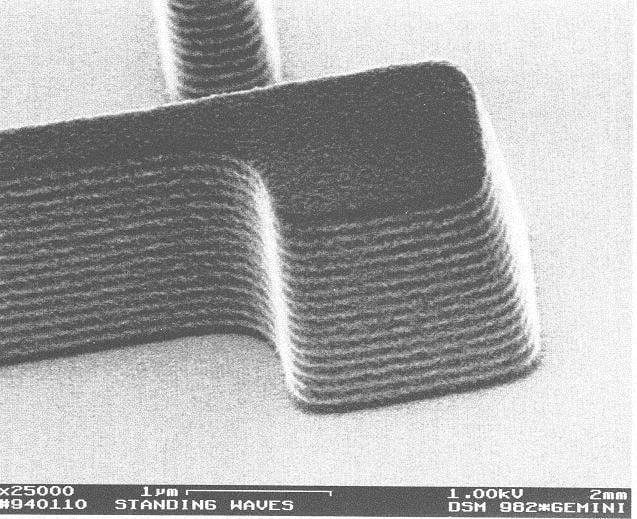
Figure: Photoresist SEM micrograph (1995) SEM= DSM 982 Gemini from Zeiss. Source: Wikipedia.
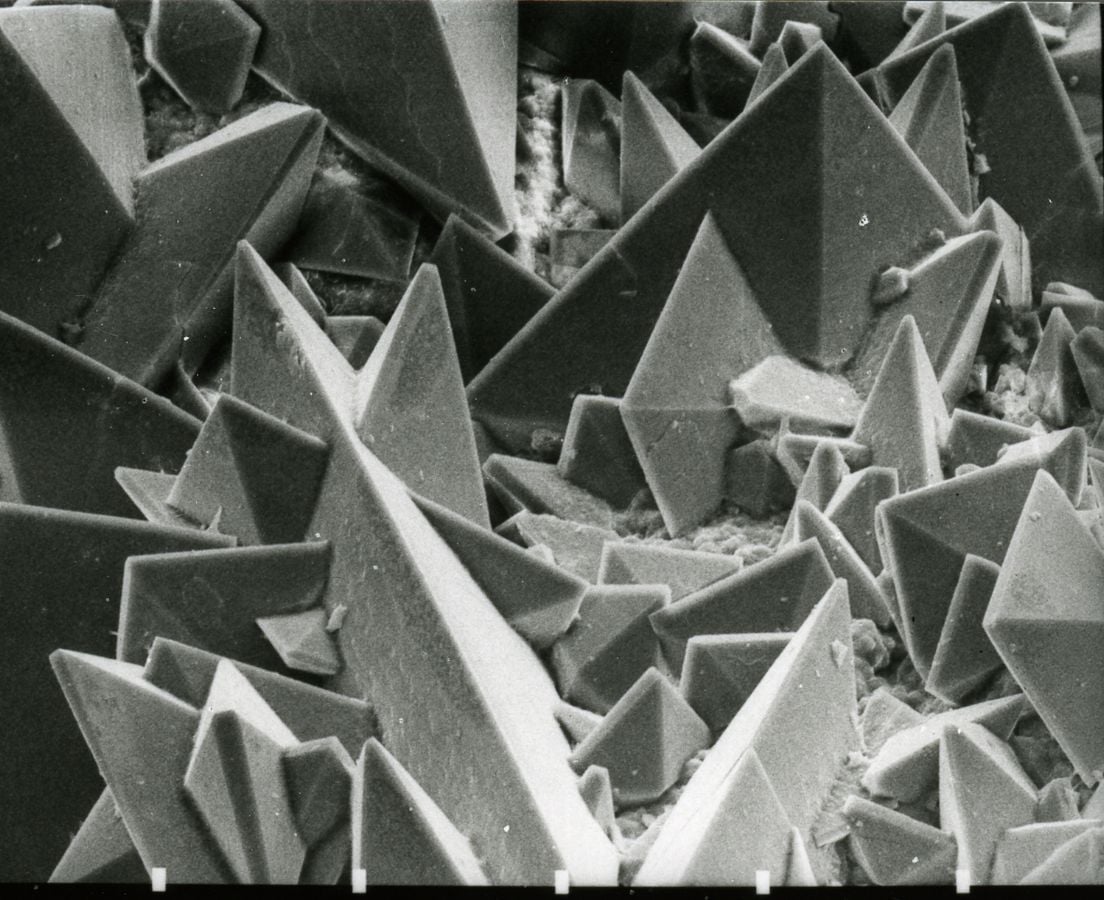
Figure: Scanning Electron Micrograph of the surface of a kidney stone showing tetragonal crystals of Weddellite (calcium oxalate dihydrate) emerging from the amorphous central part of the stone. Source: Wikipedia.
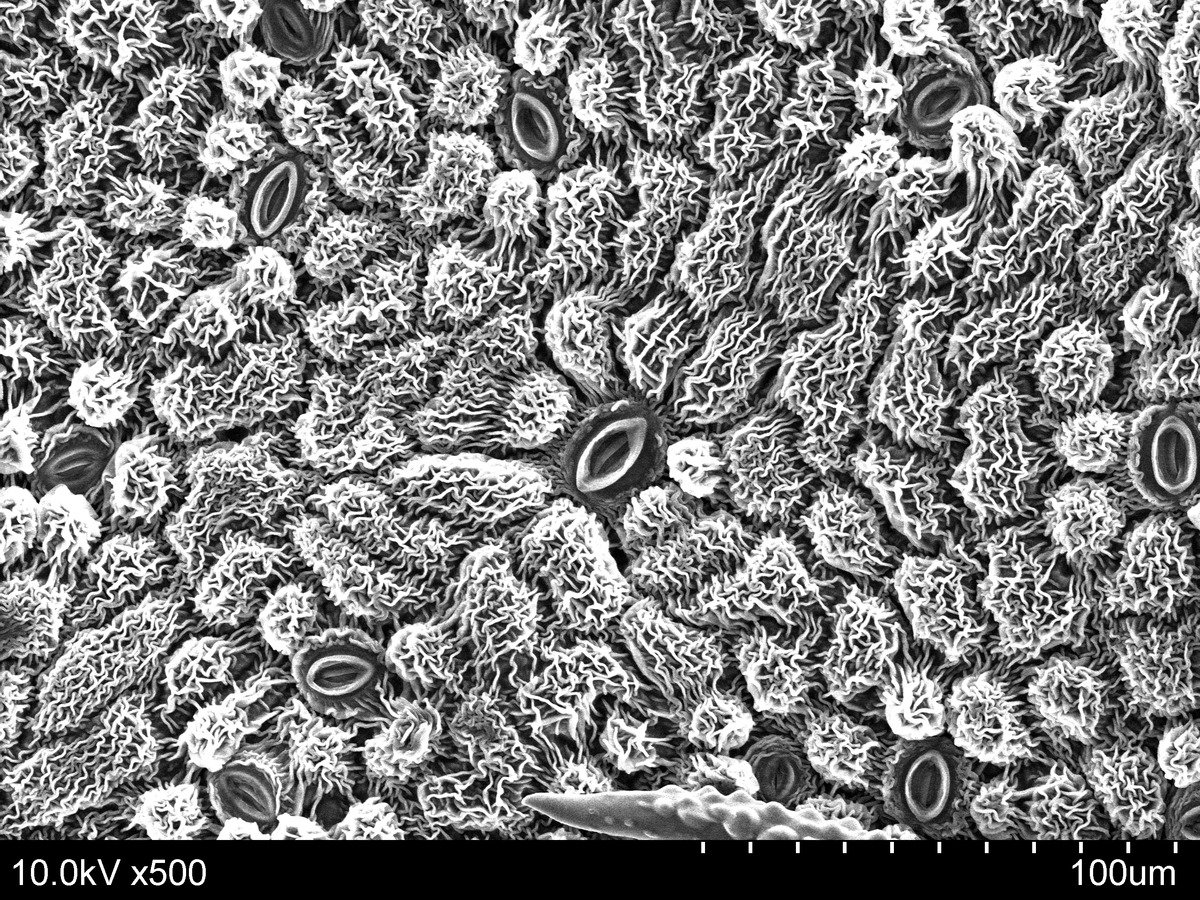
Figure: SEM image of stomata on the lower surface of a leaf. Source: Wikipedia.
Applications of the Scanning Electron Microscope (SEM)
It is used in a variety of fields including Industrial uses, nanoscience studies, Biomedical studies, Microbiology
- Used for spot chemical analysis in energy-Dispersive X-ray Spectroscopy.
- Used in the analysis of cosmetic components which are very tiny in size.
- Used to study the filament structures of microorganisms.
- Used to study the topography of elements used in industries.
Advantages of the Scanning Electron Microscope (SEM)
- They are easy to operate and have user-friendly interfaces.
- They are used in a variety of industrial applications to analyze surfaces of solid objects.
- Some modern SEMs are able to generate digital data that can be portable.
- It is easy to acquire data from the SEM, within a short period of time of about 5 minutes.
Limitations
- They are very expensive to purchase
- They are bulky to carry
- They must be used in rooms that are free of vibrations and free of electromagnetic elements
- They must be maintained with a consistent voltage
- They should be maintained with access to cooling systems
The combination of the working principles of the Scanning Electron Microscope (SEM) and the Transmission Electron Microscope (TEM) formed the Scanning-Transmission Electron Microscope (STEM). The Scanning- Transmission Electron Microscope (STEM), uses a convergent beam of electrons to focus on a probe on the specimen, and the probe is then scanned on its surface collecting signals which are then collected as point-to-point to form an image.
References
- Microbiology by Lansing M. Prescott
- https://serc.carleton.edu/research_education/geochemsheets/techniques/SEM.html
- https://www.britannica.com/technology/scanning-electron-microscope
- https://blog.phenom-world.com/what-is-sem
- https://www.atascientific.com.au/sem-imaging-applications-practical-uses-scanning-electron-microscopes/

Good
Good work
Amazing work!
All the best to you. The best description in the simplest terms; in my field of study, I would really like to be like this.
well understood!!!
Great work Madame I really wish to be like this in my field of study
Most welcome. I wish you the best.
Faith M.
Appreciate this explanation, workable for researcher of nanoscience field.
Best explanation with simple language